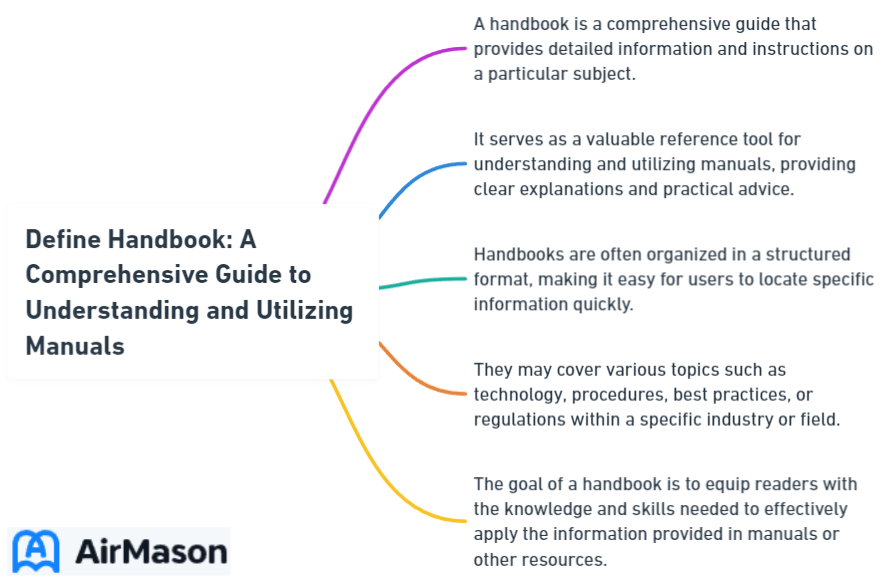
Seeking to define handbook? In essence, a handbook is a user-friendly reference source offering essential information on a specific topic or various procedures. It can be an employee guide, a technical manual, or even a traveler’s must-have. This article delves into the functions and formats of handbooks, providing you with a clear understanding of their indispensable role in both personal and professional contexts.
Key Takeaways
- A handbook is a versatile reference book that can take various forms such as manuals, guidebooks, or rule books, serving distinct purposes like providing comprehensive information on a given topic or acting as a tool for learning and instruction.
- Handbooks have evolved from ancient forms of documentation to modern digital and printed resources, adapting to include real-time updates and interactive elements, while retaining their essential function as repositories of knowledge and guides for best practices.
- Creating an effective handbook involves presenting content in a clear, accessible structure, ensuring regular updates and making use of both visual and digital enhancements to facilitate user comprehension and engagement.
Employee Handbook Requirements
Employee handbook requirements encompass the essential policies and guidelines that a company must include in its official document provided to employees. These requirements typically vary based on factors such as company size, industry, and local regulations. At a minimum, an employee handbook should cover key topics such as company policies, code of conduct, employee benefits, and disciplinary procedures. Additionally, it’s crucial to include information about employee rights, such as anti-discrimination policies and procedures for handling grievances. Furthermore, regular updates to the handbook may be necessary to reflect changes in company policies or legal requirements, ensuring that employees are always informed and compliant.
Exploring the Handbook: A Definition
At its core, a handbook is a concise reference book covering a specific subject. Fueling our curiosity and quest for understanding, handbooks have been our faithful companions offering nuggets of knowledge and information on various subjects. The term ‘handbook’ has been echoing in the corridors of history since before the 12th century, standing the test of time and evolving to meet our ever-changing needs for information.
While the term ‘handbook’ may seem straightforward, it’s a chameleon in the world of literature, cloaking itself in various other names like manual, guidebook, or rule book when the occasion demands. From an employee handbook to a company handbook or a scholarly book, a handbook can take many forms, each serving a distinct purpose.
No matter its form, a handbook is essentially a collection of resources and information, serving as a comprehensive reference source on any given topic.

The Evolution of the Handbook
The journey of the handbook is a fascinating tale. Long before the advent of digital technology, ancient civilizations used various materials like stone slabs, palm leaves, and papyrus to create early forms of handbooks. Be it Sumerian clay tablets for record-keeping or Mesoamerican codices for information compilation, handbooks have been instrumental in the preservation and transmission of knowledge, reflecting cultures of literacy, mobility, and the evolution of textual media.
With the progression of time and technological advancements, the production and distribution of handbooks experienced substantial evolution. The evolution of handbooks includes:
- The introduction of water-powered paper mills in the 11th century
- The invention of the printing press in the 15th century
- The growth of scientific disciplines and technological improvements in printing and paper production in the 19th century
These advancements expanded the production and distribution capabilities of handbooks, allowing them to cater to a wider range of subjects and topics.
Types of Handbooks
As we delve deeper into the world of handbooks, we encounter a kaleidoscope of types, each tailored to serve a unique purpose. Some common types of handbooks include:
- Employee handbooks
- Student handbooks
- Policy handbooks
- Training handbooks
These guides serve a diverse array of functions, providing guidance and clarity in different contexts, including instructions for separate essays.
We will now delve into some of the prevalent types of handbooks in further detail.
Employee Handbook: A Vital Tool for Workplaces
An employee handbook is a cornerstone in any workplace. Acting as the DNA of an organization, it houses a collection of rules, responsibilities, and procedures for the organization’s personnel. From conduct expectations to rights and responsibilities, these handbooks establish standards at the workplace, making sure everyone is on the same page.
However, an employee handbook goes beyond being a mere set of rules; it actively contributes to forming a positive work culture. By setting clear expectations for employee behavior and management roles, it reduces the risk of confusion and misunderstandings. Moreover, it plays a pivotal role in educating new hires about the company culture and values, serving as an initial touchpoint for assimilating them into their roles and the workplace environment.
Whether it’s a question about company policies or a doubt about workplace norms, the employee handbook is always at your service, contributing to transparency and consistency within the organization.
Company Handbook: Essential Business Knowledge
The company handbook is another crucial tool, serving as a comprehensive introduction to the organization’s culture, mission, and values. As the new hires step into the vast universe of your organization, the company handbook acts as their compass, guiding them through the business and ensuring a shared understanding of the company’s goals.
However, a company handbook transcends being a mere introduction. It serves as a depot for the organization’s policies and procedures, fostering legal compliance and uniform decision-making across the company. From the range of benefits offered by the organization to compliance-related entitlements and obligations, the company handbook provides a clear picture of what employees can expect from the company and where to turn for assistance.
By consistently communicating company policies, the handbook eliminates confusion and ensures that all policies are applied fairly and uniformly to all employees.
Guidebook: The Traveler’s Companion
If you’re a traveler, a guidebook can be your best friend. These handbooks are chock-full of information for navigating and enjoying different destinations. Whether it’s a must-see attraction or a hidden gem known only to locals, guidebooks provide recommendations and insights to help travelers make the most of their visit.
Guidebooks offer more than just basic information on sightseeing; they are a rich source of crucial travel tips, encompassing:
- local traditions
- dining options
- lodging
- transport details
With a guidebook in your backpack, you’re not just a tourist, you’re an informed explorer ready to delve deep into the heart of your destination.
Handbook as a Reference Book

Now that we’ve explored the various types of handbooks, let’s circle back to a fundamental aspect of these versatile tools: their role as reference books. Handbooks are designed for easy portability, allowing users to carry them for on-the-go reference. Whether you’re a co-pilot referring to operational values for specific procedures or a student seeking demographic information for a school project, a handbook serves as a reliable companion, offering specific best practices useful for clarity in professional and academic settings.
In an increasingly digital world, handbooks also facilitate internal communication and problem-solving, proving beneficial for remote workers or new hires. They can provide historical perspectives or outline standardized best practices, acting as a beacon of light in the vast ocean of knowledge. And with digital handbooks, information is not only readily available but also backed up to ensure it’s not lost and remains accessible, in contrast to printed handbooks that can be damaged or lost.
Dollar General Employee Handbook
The Dollar General Employee Handbook serves as a comprehensive guide for employees outlining company policies, procedures, and expectations. From dress code guidelines to employee benefits and conduct standards, the handbook covers essential information to ensure a positive work environment and adherence to company protocols. Employees are encouraged to familiarize themselves with the handbook to maintain compliance and uphold Dollar General’s values of integrity, respect, and customer focus. Additionally, the handbook serves as a resource for resolving conflicts, addressing concerns, and promoting professionalism within the workplace. Regular updates and revisions ensure that the handbook remains current and reflective of Dollar General’s evolving policies and practices.
The Role of Handbooks in Learning and Instruction
Handbooks are not just reference books; they are powerful tools of learning and instruction. Whether it’s a structured curriculum for students or guidelines for professional development, handbooks pave the way for a structured and consistent approach to learning and growth. From guiding learners through understanding specific tasks to helping ombudsmen navigate unique communication challenges, handbooks are a beacon of knowledge guiding us towards enlightenment.
Let’s scrutinize their roles in a particular field, such as education and professional development, more exhaustively, focusing on a particular subject.
Handbooks in Education
In the world of education, handbooks play a pivotal role. Student handbooks, for instance, contain detailed school rules, disciplinary procedures, and key rights and responsibilities, serving as a roadmap to navigate the school year. On the other hand, educational handbooks offer comprehensive references for global educational practices and teaching innovations.
Whether it’s a teacher’s handbook or an educational one, these resources often include diverse materials like:
- lesson plans
- rubrics
- standards
- instructional strategies
With the rise of digital technology, contemporary educational handbooks have evolved to address the needs of today’s tech-savvy students, exploring the integration of technology in learning.
Handbooks for Professional Development
In the professional world, handbooks serve as lighthouses guiding employees on their journey of growth. Training handbooks, for instance, offer comprehensive guidance and instruction to employees, equipping them with the necessary knowledge and skills for their roles. Employee handbooks often include information about training and development opportunities, informing employees about resources available for enhancing their skills and professional growth.
Handbooks for professional development:
- Extend beyond mere information provision
- Are tailored to meet the distinctive needs of their audience
- Address the characteristics of adult learning
- Emphasize the design and implementation of programs that cater to mature learners
Designing Effective Handbooks

The creation of an effective handbook is an art form unto itself. It’s not just about compiling information; it’s about creating a tool that is easy to navigate, understand, and apply. A well-crafted handbook features:
- A clear hierarchical structure
- Inclusive of headings, subheadings, a table of contents, and preliminary definitions of icons and symbols
- Focuses on solving the user’s problems using plain language
- Avoids unnecessary complexity in content and design
In the current digital era, a handbook should have the following features:
- Easily searchable
- Equipped with links to supplementary documentation or resources for effective problem resolution
- Effective design, engaging visuals, ample white space, and consistent fonts and colors for aesthetics
- Accessibility to serve all users effectively
- Incorporating feedback from real users to meet user requirements
Comparing Handbooks with Manuals and Other Resources
Although handbooks are invaluable resources, they are not the sole tools in our repository of information. Manuals, for instance, are user guides that provide a step-by-step process on how to use, operate, or work something. At first glance, handbooks and manuals may seem similar. However, a handbook often includes broader information than a manual and is used as a reference, for policies, or educational purposes.
In essence, while manuals focus specifically on operational procedures, handbooks may incorporate this information but are not limited to it. In other words, if a manual is a recipe, a handbook is a cookbook, offering a collection of recipes along with tips, techniques, and insights into the culinary world.
Incorporating Handbooks into Everyday Practice
Handbooks are more than just tools to be utilized in times of need; they are resources to be integrated into our daily routines. To do this effectively, handbooks should be:
- Easily accessible
- Regularly updated
- Readily available on an internal company blog or digital platform
- Provided to employees during orientations and training in both printed and electronic formats.
A well-incorporated handbook goes beyond being a reference. It serves as a practical solution to common workplace issues, providing step-by-step guidance for effective problem resolution. But it’s not just about having a handbook; it’s about ensuring its contents are understood and adhered to. This is often achieved through a signed acknowledgment of receipt by employees, ensuring they are informed about policies and agree to adhere to them.
In the digital age, handbooks can also enhance everyday use by facilitating collaboration and sharing among users, with features for exchanging notes and ideas within the text. To keep the handbook relevant and aligned with company practices and any legal changes affecting policies, regular reviews and updates are essential.
Enhancing Your Handbook: Tips and Best Practices
A handbook is not a stagnant document; it’s a dynamic entity that develops and adapts over time. To enhance your handbook, regular updates are crucial. These updates should incorporate changes in company policies or legal requirements, ensuring the handbook accurately reflects the current state of the organization.
But enhancement is not just about content; it’s also about the delivery. Incorporating visuals and infographics, and maintaining a positive and professional tone can improve engagement and readability. In the digital world, handbooks can leverage analytics and tracking to monitor how users interact with the content, enabling authors to make informed decisions about future updates.
And let’s not forget about design. Utilizing free design templates, like those offered by Piktochart, can assist in the creation of effective and visually appealing handbooks without extensive design experience.
Handbook Formats: Print vs. Digital

In the context of handbooks, a common query arises: Should it be in print or digital format? Both formats have their own advantages and disadvantages. The digitization of information has led to a transformation of traditional handbooks into online and digital formats, thanks to changes in technology and user information access preferences.
Digital handbooks offer the following benefits:
- Environmental benefits
- Cost savings
- Real-time updates
- Interactive elements such as search functions, hyperlinks, and multimedia to enhance user experience
- Accessibility from multiple devices
- Encryption for security, providing portability, convenience, and enhanced security for sensitive information.
Despite their advantages, digital handbooks can face technical issues such as compatibility problems or file corruption, and they are dependent on having appropriate technology and power sources. On the other hand, printed handbooks:
- are tangible and not requiring technology
- are free from technical issues
- allow for easy note-taking and personalization
- promote memory retention through physical interaction
So, whether you prefer the smell of fresh print or the convenience of digital access, there’s a small book ready reference handbook format for you.
Allied Universal Employee Handbook
The Allied Universal Employee Handbook serves as a comprehensive guide for employees, outlining company policies, procedures, and expectations. Within the pages of the Allied Universal Employee Handbook, employees can find valuable information regarding workplace conduct, safety protocols, benefits, and career development opportunities. This handbook is an essential tool for new hires as well as existing employees, providing clarity and consistency in navigating the organization’s policies and practices. By familiarizing themselves with the contents of the Allied Universal Employee Handbook, employees can ensure compliance with company guidelines and contribute to a positive and productive work environment.
Summary
As we draw to a close on our exploration of handbooks, we can reflect on the rich tapestry of knowledge we’ve uncovered. From their humble origins in ancient civilizations to their modern-day manifestations in digital formats, handbooks have always been a beacon of knowledge, guiding us through various facets of life. Whether it’s an employee handbook setting the tone for workplace culture, a company handbook outlining business knowledge, or a guidebook helping us navigate new travel destinations, handbooks serve as our faithful companions on our quest for understanding.
But the journey is far from over. As we step into the future, handbooks will continue to evolve, adapting to our changing needs and technologies. They are not just repositories of information; they are living entities, growing and adapting with us. So, the next time you hold a handbook, remember, you’re not just holding a book; you’re holding centuries of wisdom, knowledge, and evolution in your hands.
Frequently Asked Questions
What is the meaning of the hand book?
A handbook is a book that provides advice and instructions about a specific subject, tool, or machine.
What are the three types of handbook?
Handbooks come in different forms and serve various purposes. Common types include employee, student, policy, and training handbooks, each catering to specific audiences and providing relevant information.
What is the difference between a manual and a handbook?
A handbook provides comprehensive knowledge on a subject, covering a wide range of topics, while a manual focuses on specific tasks or processes, providing detailed instructions.
What is the purpose of a handbook?
The purpose of a handbook is to serve as a concise reference book, providing information and guidance on a specific subject, such as employee policies or company procedures. Whether it’s an employee handbook, company handbook, or guidebook, each serves a different function and caters to specific needs.
How has the handbook evolved over time?
The handbook has evolved over time through technological advancements in printing and paper production, covering a wider range of topics and becoming more accessible. Today, handbooks continue to be an essential resource in various fields.
Important Disclaimer:
Please be aware that the content on this page has been generated by using artificial intelligence language models and may contain errors, inconsistencies, or outdated information. It is provided as-is without any warranties or guarantees of accuracy.
We strongly recommend using this content as a starting point for further research. We disclaim any liability for damages or losses resulting from the use or reliance on this content.